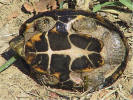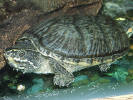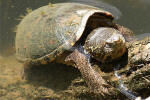|
|
|
|
|
Stinkpots have the standard North American musk turtle form-factor; small oval-shaped turtle with a reduced, almost ‘surf board’ plastron (more mobility than a mud turtle at the cost of reduced protection; grayish skin is seen up the center & between plastral scutes) & a large head (variable degree; useful for crushing snails). Overall coloration tends toward gray or black, with some northern stinkpots tending toward brown & more southeast (particularly in Florida) specimens being blacker. A pair of irregular horizontal yellow ‘lightening’ stripes run along the side of the face & head on each side. These stripes run past the eye out to the nose, like a 3-striped mud’s but unlike a Mississippi mud’s (which stop at the eye). Small barbells are present on the underside of the head. The jaws are powerful & can crack snails; bites can be excruciatingly painful. North American musk & mud turtles lack the ‘power strike’ of common snappers & when handled often withdraw into their shells, sometimes with jaws agape. More pugnacious individuals may extend the head a bit but generally don’t make the lunging strikes common snappers do. Musk turtles tend to have more pointed faces than mud turtles. Males have larger tails, nearly the size of a leg, thinner past the cloacal opening. Females’ tails are small without such evident post cloacal tapering. Males do not have long fore-claws as seen in cooters & sliders. Hatchlings have a strongly keeled carapace with a strong dorsal ridge down the back. The carapace looks like rough slate. The keeling diminishes as the turtle grows, although some males retain a rough slate look to the carapace a few years before achieving the classic ‘polished stone’ look. The yellow head striping varies in distinctiveness & may fade entirely in some adults. Stinkpots take their name from small glands on the underside of the carapace that can exude a foul-smelling musk in self-defense; captives don’t do this often & it is not a hygiene issue (your house won’t stink because you keep one). Other mud & musk turtles & common snappers have this capability. Stinkpots are amongst the smallest North American turtles, reaching about 4-5” SCL. They are slower-growing than common North American basking species such as sliders & painteds. Hatching start out at SCL 18.5-22.8 mm (per Turtles of the United States & Canada, Page 147)1 (roughly 0.73 to 0.90 inches). |
||
|
|
|
|
|
|
|
|
Stinkpots enjoy one of the largest natural ranges of any North American turtle, ranging from minor penetration into southeastern Canada down through the south-eastern & south-central U.S. (Painted turtles & common snappers are larger ranges). |
||
|
|
|
|
|
|
|
||||
|
TEMPERATURE RANGE (°F)
Adults stinkpots are hardy turtles thriving in a range of non-brackish permanent freshwater habitats. However, hatchlings are very tiny & somewhat frail. One might surmise adults would be suitable for year-round outdoor keeping (including hibernation); be warned those of southern ancestry may not be adapted for harsh northern winters (this is speculation, but the bulk of U.S. turtle production takes place in the south & south-east). If outdoor hibernation in northern North American is key, obtain one of northern ancestry.
Yes, one of the very best. Hardy, easy to care for (as turtles go), aquatic, hibernation-capable/temperate-tolerant & permanently small. However, we recommend beginners start out with an older juvenile (SCL at least 1”) since hatchings are quite fragile. CAPTIVE DIET Wild stinkpots are predominantly carnivorous opportunists with minor vegetation intake whose diet varies by availability of prey. Turtles of the United States & Canada, Page 1481 provides detailed dietary information; rough rounding off (for simplicity) of research data cited there (Mahmoud 1968)2 suggests the wild diet by stomach content volume is around 46% insects, 24% mollusks, 5% crustaceans, 1% amphibians, 3.4% carrion & 20.4% aquatic vegetation. So stinkpots are not adapted to catching fish (lacking lures like alligator snappers, or the ‘power strike & sometimes inhale’ technique of chicken turtles & common snappers); they go for insect larvae, snails, leeches, crayfish, etc… Regarding natural plant consumption, Bancroft et al.3 reported 99% of the plant biomass in stinkpot stomachs was composed of by the genera Nuphar 56%, Vallisneria 26%, Eichhornia 8% & finally filamentous algae 9%. In captivity stinkpots tend to favor carnivorous food items like aquatic turtle pellets, snails, earth worms, grasshoppers, crickets, ghost shrimp, small crayfish & commercial aquatic turtle pellets are taken. Mine seldom shows interest in aquatic plants or Romaine lettuce but will eat Spirulina algae wafers & commercial tortoise pellets. A youngster may be slow to warm to commercial pellets. Wild snails are known to be intermediate vectors of a number of indirect life cycle parasites affecting a range of animals, & snails of the genus Goniobasis are known to transmit lung flukes to loggerhead musk turtles. Therefore we recommend you avoid feeding wild-caught snails to stinkpots. If you don’t provide UV-B lighting, make sure the diet includes Vitamin D3 sources such as a brand name commercial food (i.e.: ReptoMin or Mazuri aquatic turtle foods). RECOMMENDED FEEDING SCHEDULE For the first 6 months of life, feed commercial pellets or meaty foods such as earthworms or fish once daily, enough to diminish appetite but not gorge the turtle. After 6 months, switch to every other day feeding. Romaine lettuce & other leafy greens may be offered daily for graze at will (if your stinkpot is an odd-ball & likes plants). Over time adjust diet content & schedule accounting for growth, activity level & appetite. Overfeeding high-protein foods can cause rapid growth& is believed harmful to the liver & kidneys. That said, musk turtles don’t appear as prone to shell deformities (pyramiding) from over-feeding as basking turtles. CAPTIVE HABITAT Wild stinkpots are heavily aquatic & seldom leave the water except to lay eggs or bask. Turtles of the United States & Canada1 Page 142 states they usually prefer the shallow water of littoral zones & that most bottom activity is at depths of less than 60 cm, although research is cited (Minton, 1972)4 that they’ve been observed at 9 m depths, & McCauley (1945)5 and Carr (1940, 1952)6,7 found it in water 3-9 m deep. I observe them in the wild near shore scampering about on muddy bottoms or submerged plant mats looking for food. I photographed wild stinkpots basking many times along the small Little River in Southwestern KY, Spring through Summer & Fall, so I disagree with the popular wisdom that they rarely bask or do so mainly by resting at the surface. Their small size, drab coloration & shy nature make them hard to spot & harder to recognize. Captive stinkpots vary widely in basking, from often to almost never, but a basking platform should be provided. If nothing else, it may be life-saving if your submersible heater malfunctions. Stinkpots swim well but do not float or ‘hover’ so well as ‘basking’ turtles such as sliders & painteds, so deep water tanks with no structures to climb/rest on pose a fatigue & drowning hazard. RECOMMENDED ENCLOSURE We recommend a minimum 29 gallon tank size (the bigger the better), given their fairly active nature. For adults fill the tank any depth 10 inches to 2 feet (at least part of the enclosure should be no deeper) that doesn’t allow escape, but include plenty of large underwater structures (driftwood, synthetic rocks & logs, mats of real or artificial plants, etc…) for climbing & exploration. Stinkpots like to climb to the surface more so than swim. Hide cave-type areas are appreciated. Strong filtration is recommended for these fairly messy carnivores. Current can be mild but shouldn’t be strong. A basking platform & heat lamp should be provided. A submersible heater to ensure water temp.s don’t drop far is recommended, preferably with a heater guard to reduce burn risk. UV-B lighting is strongly recommended if you aren’t confident dietary Vitamin D3 is sufficient, particularly for growing hatchings in shallower water enclosures. Substrate isn’t critical but a complex landscape to explore could include river rock. WATER DEPTH Stinkpots occupy a range of depths but tend toward shallow; for adults provide water 10” to 2 ft. deep, with plenty of submerged structures. COMMUNITY HABITAT Overall, fairly compatible. Stinkpots typically mix well with basking turtles (cooters, painteds, sliders, etc…) once adult. Because hatchlings are fragile & more slow-growing than basking species, if you must raise stinkpots with baskers start off with a stinkpot at least 1.5” SCL, at least as large & preferably a bit larger than the basker. Stinkpots may be aggressive toward other turtles, particularly their own or very similar-looking species (could be an issue with Mississippi & 3-striped muds). Be especially watchful when mixing male stinkpots. Like any turtle individuals may be ‘antisocial’ & require solitary housing, & they have the jaw-power to do serious damage (like biting off a leg). If a stinkpot demonstrates open hostility isolate it quickly. Male stinkpots may sexually harass other species, which may become an issue. Stinkpots aren’t well-equipped for fishing & eat little plant matter, so they’re more compatible with fish & planted tanks than some popular basking species. |
||||||
|
|
|
|
|
|
|
|
Turtles of the United States & Canada1 Page 146 states usual clutch size run 2-5 eggs, natural incubation ranges from 65-86 days & hatchling emerge August – November (varied by latitude); Page 147 cites research (Vogt et al., 198210; Clark et al., 198611) stating sex is temp.-determined with incubation at 28ºC producing nearly all females & cooler temp.s mixed clutches; 25ºC produces as much as 80% males. |
||
|
|
|
|
|
|
|
|
ENCLOSURE A good setup is a 20 to 29 gallon aquarium with 3-4” of water & plenty of plants (preferably Anacharis, which is bushy & soft) for support, & driftwood. Set water temp. to 80ºF. Provide a basking area & can be as simple as a piece of cork bark) with temp.s around 85-90ºF. Filtration of shallow-water habitat can be challenging; options include the Duetto DJ-100, Ovation & the Tetra Whisper In-Tank PF-20i & 40i models. Be very careful that water evaporation doesn’t expose any of the submersible heater, least it overheat & burn or broil the turtle. Over a few weeks as the turtle eats, grows & demonstrates good health you may deepen the water. By the time the turtle clear 1” SCL, 8” of water if fine. DIET Per ‘Recommended Feeding Schedule,’ modified as follows. Youngsters may or may not take to commercial foods. If they do not take in food known to contain Vitamin D3 (typically commercial foods), provide UV-B lighting. Bloodworms are fine for coaxing reluctant feeders but nutritionally insufficient for a staple. Finely shopped small earthworm bits, freshly killed & crushed guppies & small feeder crickets & grasshoppers are fine choices. Hatchlings are shy & fragile so don’t try feeding outside the tank until at least several weeks of well-being feeding in the tank (if you do this at all). BEHAVIORAL NOTES Activity Cycle: Turtles of the United States & Canada states they are chiefly nocturnal & during daylight hours generally inactive (remaining buried in mud or resting on the bottom) although an occasional stinkpot may been found crawling on the bottom at any time. Research is cited suggesting activity peaks from late night to late morning and late evening to early night. I’ve seen stinkpots cruising the bottom by day a number of times in SW KY & don’t consider daytime activity or basking at all unusual. Hatchings are evidently extremely secretive; in the wild I find plenty of adults & sub-adults but not hatchlings. Personability with Humans: Stinkpots vary from quite personable to quite shy, but are not as consistently calm & tolerant of close proximity as basking species such as sliders & painteds. Basking: Some captive stinkpots bask far more than others. Unfortunately, this can signal sicknesses such as pneumonia. If your juvenile basks often, water for lethargy, reluctance to flee to water & refusal to eat. As long as it is alert or wakes quickly, retreats to water or at least when pushed in swims & stays under readily, & eats well it should be fine. |
||
|
|
|
|
|
|
|
|
BIBLIOGRAPHY 1.) Turtles of The United States and Canada –Carl H. Ernst, Jeffrey E. Lovich and Roger W. Barbour. Smithsonian Institution Press, Washington and London. ©1994. (Possibly the preeminent natural history text of North American turtles – very highly recommended). 2.) Mahmoud, I. Y. 1968. Feeding behavior in kinosternid turtles. Herpetologica 24:300-305. 3.) Bancroft, G. T., J. S. Godley, D. T. Gross, N. N. Rojas, D. A. Sutphen and R. W. McDiarmid. 1983. Large-scale operations management test of use of the white amur for control of problem aquatic plants. The herpetofauna of Lake Conway: Species accounts, Misc. Pap. A-83-5. Army Engineer Waterways Exp. Stat, Vicksburg, Mississippi. 354 pp. 4.) Minton, S. A., Jr. 1972. Amphibians and reptiles of Indiana. Indiana Acad. Sci. Monogr. 3:1-346. 5.) McCauley, R. H. 1945. The reptiles of Maryland and the District of Columbia. Privately printed, Hagerstown, Maryland. 194 pp. 6.) Carr, A. F., Jr. 1940. A contribution to the herpetology of Florida. Univ. Florida Bio. Sci. Ser. 3:1-118. 7.) Car, A. F., Jr. 1952. Handbook of turtles. The turtles of the United States, Canada, and Baja California. Com-stock Publ. Assoc., Cornell University Press, Ithaca, New York. 542 pp. 8.) Ernst, C. H. 1986. Ecology of the turtle, Sternotherus odoratus, in southeastern Pennsylvania. J. Herpetol. 20: 341-352. 9.) Mahmoud, I. Y. 1969. Comparative ecology of the kinosternid turtles of Oklahoma. Southwest. Natur. 14:31-66. 10.) Vogt, R. C., J. J. Bull, C. J. McCoy, and T. W. Houseal. 1982. Incubation temperature influences sex determination in kinosternid turtles. Copeia 1982:480-482. 11.) Clark, P. J., M. A. Ewer, and C. E. Nelson. 1986. Physiological aspects of temperature dependent sex. Proc. Indiana Acad. Sci. 95:519. |
||
|
|
|








